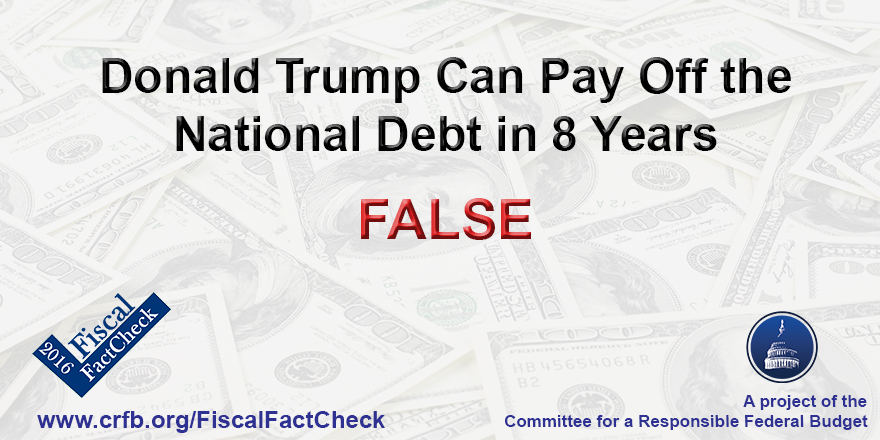Can Donald Trump Pay Off the National Debt in 8 Years?
In a recent interview, presidential candidate Donald Trump said he would pay off the nation’s $19 trillion debt “over a period of eight years.”
He can’t. The numbers don’t add up. In fact, our estimates of Mr. Trump’s plan so far show debt will instead double to above $38 trillion.1
Setting aside whether paying down the debt makes economic sense, achieving this goal would be virtually impossible – particularly for a candidate who has proposed large tax cuts and ruled out significant entitlement reforms. Paying off the debt would require unprecedented tax increases, spending cuts, and economic growth.

Spending Cuts or Economic Growth Wouldn’t Do It
Gross debt (currently $19 trillion) will reach nearly $28 trillion by the end of 2025.2 To save that much money would require cutting all spending by two-thirds or achieving 16 percent real annual economic growth; growth is currently projected to average 2.1 percent.
Excluding Social Security – which Mr. Trump has said he would not significantly change – the rest of government would need to be cut by 93 percent.
Donald Trump has also proposed over $10 trillion of tax cuts and spending increases through 2025. Incorporating these, spending would have to be cut about 90 percent and the economy would have to grow more than 20 percent per year.
Asset Sales Won’t Do It
Selling federal assets couldn’t cover this $28 trillion to $38 trillion of costs. According to the Financial Statement of the United State Government, the government holds only $3.1 trillion of assets (excluding stewardship assets and natural resources) – and much of that couldn’t or shouldn’t be sold, at least not for a significant profit.
Trade Can’t Do It
Nor would Mr. Trump’s suggestion of “renegotiating all of our deals…the big trade deals that we’re doing so badly on” help to pay down the debt. The trade deficit has only an indirect economic relationship with the budget deficit, and outside of some small amount of tariff revenue and modest GDP effects, better trade deals would not significantly impact the national debt. In all likelihood, Trump’s changes to trade policy would reduce rather than enhance growth, according to several economists.
Donald Trump’s Policies Won’t Do It – They Will Increase the Debt
Ultimately, no plausible set of policies could pay off the debt in eight years; this would require deficit reduction 13 to 18 times as large as what the President has put forward and 4 to 6 times what House Republicans have called for. And neither of these proposals cut net taxes nor take Medicare and Social Security off the table.
Rather than pay off the debt, Donald Trump’s policies – as proposed so far – would increase it.
Our Rating: False
1 $38 trillion represents the almost $28 trillion that the gross debt will reach under CBO’s current law projections, plus our “low” estimate of the total cost of the policies on Mr. Trump’s website. We projected those policies would add at least $11.7 trillion to the debt by 2026. Here, we’re using a figure of $10 trillion by 2025, to account for the fact that Trump’s claim is over eight years.
2 These numbers refer to the gross federal debt, which as a technical matter would be quite difficult to pay off because it includes debt the government owes itself in various trust funds. Instead, we assume Mr. Trump is aiming to generate an amount of savings equal to the gross federal debt. For purposes of this analysis, we assume his goal is to do so by the end of the 8th full fiscal year starting from the next President’s first day in office. This allows for 8 years and 8 months in total.


